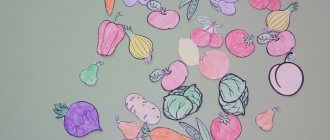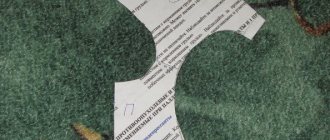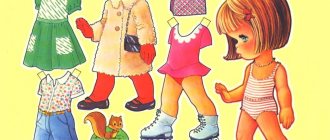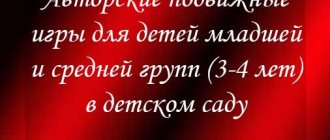Objectives of the game and preparation of didactic material
The locomotive for the game is a flat image made of cardboard, each car of which is painted in a certain color from the main palette. Transparent cells are attached to the carriages, into which game material is inserted. Various thematic images are used as material: numbers, geometric shapes, pictures of animals and plants, objects, transport and other things.
During the game, the train can be placed on a horizontal surface. Or you can hang it on a magnetic board - this is a more convenient and ergonomic option, allowing you to start playing at any time. If the train is attached to the board, the pictures should also have magnetic attachments. The number of trailers can be any, depending on what games the teacher plans to play with the students. The minimum quantity is 3 cars. But it’s better to do more, and then use all the trailers or only part of them for games.
The goals of the game are the diversified development of preschool children, including those with mental and speech disabilities.
The objectives of games with a train:
- expanding ideas about the world around us;
- strengthening cognitive interest;
- improvement of speech and thinking abilities;
- developing the skill of classification and ordering of objects;
- expanding mathematical knowledge, gaining the skill of counting, determining quantities;
- consolidation of ideas about geometric shapes and primary colors;
- development of fine motor skills, memory, perseverance, concentration.
For children of different age groups, you can come up with all kinds of games with a train.
TRIZ – manual “The Cheerful Little Engine”
TRIZ – manual “The Cheerful Little Engine”
Explanatory note.
TRIZ – “The Cheerful Little Engine” manual was developed for children aged 3-7 years.
Educator: Galkina Elena Alekovna, work experience 8 years.
Educator: Nikitina Tatyana Gennadievna, candidate of technical sciences, category 1, work experience 5 years.
Relevance.
The modern world is changing rapidly, and information technology gives us new opportunities, but also demands a lot from us. A person has to cope with a mass of creative tasks that constantly “fall” on him; this applies not only to professional and scientific activities, but also to everyday life. Society needs people who are independent, creative, and able to make non-standard decisions. How to teach children to live fully in a dynamic, rapidly changing world? How to raise a person who can easily solve problems that arise? Today, one of the priority areas of pedagogy is the task of developing creativity. Learning through creativity, through solving non-standard problems, leads to the identification of talents, develops children’s abilities and their confidence in their abilities.
TRIZ - the “Happy Little Engine” manual for children has educational value. It helps teach children to analyze everything that happens around them, to see the phenomena of a system not only in structure, but also in time dynamics. Trains visual-figurative thinking, verbal-logical thinking, active vocabulary. Children reinforce the ability to group and classify objects using game exercises. During the game, children develop the habit of thinking independently, focusing, and taking initiative.
TRIZ manual “The Cheerful Engine”
The manual is used for games to determine the development line of an object and to compare systems.
Age
from 3 to 7 years.
Target:
Develop an understanding of simple cause-and-effect relationships.
Contents of the manual:
felt locomotive and carriages, set of cards
The manual can be used for several games:
“What does it look like?”
(conducted from the 2nd junior group)
Rules of the game: the leader names the object, and the children name objects similar to it.
Note: Objects can be similar according to the following characteristics: by purpose (function), by subsystem, by supersystem, by past and future, by sound, by smell, by color, by size, by shape, by material. Even very different objects can be similar. You can use subject pictures, especially at the stage of familiarization with the game.
The presenter asks to explain why the player decided that the named objects are similar.
Educator: What does a hedgehog’s thorn look like?
Children: On needles, on pins, on nails. On pen rods, etc.
Train and carriages
The game, which reinforces counting skills, is intended for preschoolers aged 4–6 years.
The teacher places images of numbers from 1 to 10 in the carriage cells, then asks the children to attach the carriages to each other in the correct order.
Didactic math game for preschoolers 3-6 years old
Didactic game for preschoolers “Mathematical Engine”
Author: Natalya Evgenievna Khokhlova Position: teacher-defectologist, MKDOU No. 18 (branch), Miass, Chelyabinsk region Name of resource: didactic game “Mathematical Engine” Brief description of the resource: game for preschool children on formation of elementary mathematical concepts, development of logical thinking. The purpose and objectives of the resource: strengthening counting skills, number composition, number series, ordinal counting; development of visual perception, logical thinking. Relevance and significance of the resource: the game can be used by speech therapists, defectologists, and parents in correctional work with children. Equipment: the game is made using a PC (personal computer), consists of planar images: a steam locomotive, trailers, wheels for trailers. Practical application: individual lessons, frontal correction lessons (as a demonstration of a task or a direct game “one at a time”). Method of working with the resource: 1. Individually: the child takes one of the trains.
A number is depicted on the wheel of the locomotive, the child places a trailer next to it and matches the wheels with numbers or dots to the trailer so that in pairs they make up the indicated number. 2. Front: used to demonstrate a task using a magnetic board and magnets; Children in their seats work orally and frontally. This game is aimed at strengthening counting skills and number composition. Option I
Place a train with several carriages in front of the child (the number of carriages depends on the child’s mastery of counting limits) and offer to number the carriages in order. For numbering, you can use any cards with numbers or use wheels from trailers.
For example, a train within 3
Then invite the child to count the total number of trailers, or count them in order, thus strengthening the ordinal count. Or, as an option to reinforce ordinal counting, invite your child to line up the trains with the numbers depicted on them in order.
Option II
Offer your child one of the trains with a certain number. Ask to prepare it for a long trip. But for this he needs to attach trailers. We don't know how many there will be. Therefore, we begin to attach one trailer at a time and select wheels for the trailer so that a pair of wheels together makes up the number depicted on the train. Carriages:
Wheels:
You can use wheels with dots or numbers. For example, the following trains can turn out:
You can invite your child to count how many trailers the locomotive will carry. Come up with other tasks using this material. I wish you creative success!
We recommend watching:
Passport for the senior group math corner Mathematical game in kindergarten for preschoolers with learning difficulties Do-it-yourself didactic game for preschoolers 4-6 years old according to FEMP Mathematical games for preschoolers 3-5 years old in kindergarten
Similar articles:
Math tasks in pictures for children 6-7 years old
Exercises with counting sticks for preschoolers
Teaching mathematics using the Nikitin method
Math problems jokes for preschoolers
Mathematical riddles for preschoolers in verse with answers
Didactic game "Merry little engine"
This game for preschoolers aged 5–6 years also improves counting skills and develops thinking abilities and spatial orientation.
The teacher asks the children to connect the cars, insert cards with numbers into the cells in the correct order. Students, having completed the task, list the numbers, first in direct order, then in reverse. Next, the teacher calls a number, the children find the corresponding trailer, name the adjacent numbers on the right and left sides.
Animal world
Need a set of images of birds and animals. You can play with these pictures in different ways:
- Distribute the pictures among the carriages in accordance with the categories “Wild Animals”, “Domestic Animals”, “Wild Birds”, “Domestic Birds”.
- Distribute the animals among the carriages. Name the passengers who travel to the Lesnaya and Selsky Dvor stations.
- Place the animals in the carriages and count their number. Name who travels in the first carriage, in the second and subsequent ones. Who sits in a certain carriage, who travels on the right and on the left side of it.
The engine from Romashkovo
Master class quest game using a multi-purpose teaching aid for children of senior preschool age
Do-it-yourself multifunctional teaching aids are an effective means for the comprehensive development of children. The advantages of such manuals: the ability to prepare games with your own hands; efficiency; solving problems in various educational fields; made from environmentally friendly materials; the opportunity to involve both parents and students in the production of the manual; the ability to supplement the manual with various attributes and details in accordance with the assigned tasks; the use of such benefits in individual and subgroup work with children, in various types of activities; the possibility of rational arrangement in the subject-spatial environment. The teaching aid “Locomotive from Romashkovo” is now actively used in subgroup individual educational activities in the senior group for children with special needs.
Target
: show the possibilities of using the innovative teaching aid “Locomotive from Romashkovo” in educational activities.
Objectives
: show how the author's didactic manual can be used in various types of educational activities;
develop cognitive interest and creative activity of teachers in the course of practical activities; increase the motivation of teachers to use innovative teaching aids. Materials and equipment
: badges with serial numbers for volunteers, carpet for placing train cars, trays with felt components of the car, object pictures, attributes and clothing of the characters (scarf for a grandmother, bandage and cap for a man, doll, baseball cap and headband), sheets of A4 paper with drawn geometric shapes, felt-tip pens, markers.
Progress of activities
Using an example of a quest game for teachers, we will show how one of the teaching aids we have prepared can be used to solve problems in all educational areas. So, “Locomotive from Romashkovo”. I invite five volunteers to go up on stage. Wake up people - they are calling you to volunteer! Help us now, choose the path clearly. If a good heart or soul calls, Help me help, the team is waiting for you! ( The assistant meets the volunteers on stage and fastens a badge with a serial number
.)
Our little train is going on a journey. We will soon learn what is most important and valuable in life for each person. When traveling, you need a route, and the map that the Federal State Educational Standard compiled for us will help us with this.
Departure station "Cognitive development"
For us to hit the road, we need to assemble the train.
Colleagues, take the trays according to the number on the badges, and assemble each of your carriages so that we have a train. All the carriages are assembled, attached to the locomotive and our train is ready to travel. What cognitive development tasks did we solve when completing this task? They consolidated quantitative and ordinal counting, correlating the number of objects with numbers, and the formation of the perception of shape, size and color. Well done, you completed the task. Get your first clue. Now let's go!
Station "Speech Development"
( The assistant places in each carriage pictures of young wild and domestic animals in number in accordance with the serial number of the carriage. Pictures of adult animals are placed on the platform.
) Here our train is moving, the wheels are knocking, and on our train... Who is riding on our train? Now we will find out!
Who is riding in the first carriage? ( Calf and bear cub
.) And in the second?
( Foals and foxes
.) Who is riding in the third carriage?
( Kids, hedgehogs
.) In the fourth?
( Puppies, squirrels.
) In the fifth trailer?
( Kittens, bunnies
.) Who meets the bunnies?
( The little hare meets the hare.
) Who meets the fox cubs?
( The fox meets the cubs.
) Who meets the calf?
( The calf is met by a cow
.) In this game we activate the dictionary on the lexical topics “Wild and Domestic Animals”.
( The assistant places pictures of vegetables and fruits on the panel. The game continues.
)
With the help of a train, we can consolidate children's knowledge on lexical topics, enrich their vocabulary, practice grammatical categories, while continuing to develop coherent speech. For completing the task correctly, you receive another hint. The journey continues. ( The assistant removes the subject pictures
.)
Station "Physical Development"
We've been driving for a long time, it's time to get out on the platform and move around a little. The stopping time at this station is limited to 30 seconds. I invite the audience in the hall to join our warm-up. ( There is a dance warm-up to the children's song “The clock is ticking...”
) We moved well and deserve another hint!
There are different people waiting on the platform for the train. A boy, a girl, an old grandmother, a sick man, a woman with a child. (The assistant distributes attributes and clothes of the heroes: a scarf for the grandmother, a bandage and cap for the man, a doll, a baseball cap and a headband.) Boarding is announced. Passengers are asked to take their seats in the carriages. Be mutually polite! The passengers' task is to enter the carriage in accordance with the rules of etiquette. ( Participants line up in front of the carriage in a certain order
.)
Well done, you completed the task and receive the fourth clue. And we are heading to the final station!
Station "Artistic and Aesthetic Development"
Do you like looking out the window when you're on the train? Watch the forests and fields, cities and villages, magnificent landscapes passing by. Draw the most memorable view that you saw from the train window, completing the contours of the geometric shapes offered to you. ( The assistant distributes sheets with images of a square, rectangle, triangle, oval and circle, the participants draw.
) We have completed our journey through all educational areas, collected all the clues and can solve the rebus.
Answer the question, what is the most important and valuable thing in the life of every person? ( Family
.)
Thus, using the activity approach, you can use any didactic manual to solve problems in various educational fields. Thank you for your attention!
Alexandra Kuznetsova, senior
teacher Irina Loginova, teacher at MBDOU "Kindergarten No. 1", Salavat, Republic of Bashkortostan
Musical and didactic game "Locomotive"
The game develops a sense of rhythm and an ear for music. It should be held in the music room. You need to prepare images of different musical instruments and insert them into the cells of the trailers.
Children take turns approaching the train, pulling out a picture from the box, and naming the instrument shown. Next, the child approaches the table with musical instruments laid out, takes the one that matches the picture, and tries to play it. It is important that the tools used are appropriate to the age-related abilities of preschoolers. These can be musical spoons, a triangle, a drum, a bell.
Didactic railway games for primary preschool age
Kindergarten is the first important stage in the training of future railway workers. The teaching staff carries out systematic work to familiarize children with railway transport and the professions of railway workers. The possibility of early career guidance is determined by the following factors:
• Preschool age of children is the most favorable period for the development of curiosity . This allows children to develop an active interest in railway professions.
• Parents of pupils work at the enterprises of JSC Russian Railways, and for children of this age it is natural to be interested in the work of their parents and to want to become like their fathers and mothers.
The implementation of this project is impossible without creating conditions for the education of future railway workers in kindergarten.
To do this, in younger groups, teachers use game aids - light geometric modules, covered in leather, which are easily rearranged in the process of transforming space, and didactic games made according to their own design.
We also involve parents in making games. These include picturesque rugs with removable image elements that can be transformed using buttons, Velcro or loops with buttons, and games made from waste material (many experts have noticed that children like everything new, non-standard, unusual).
We believe that such games allow children not only to transform the environment, but also contribute to their development in general.
Goal: development of speech and fine motor skills.
Progress of the game: small objects (various figures from Kinder Surprise) are laid out on the table at a distance of 5-7 cm from each other. When moving a chip (train), you need to go around all the obstacles without hitting it, naming the object.
Goal: develop visual memory. Fix the basic geometric shapes.
Progress of the game: the child is offered a picture covered on top with a white sheet with one hole. If the child cannot guess the picture, he is offered the same picture, covered with a sheet with two holes. And so on until the child names what is shown in the picture.
Goal: To consolidate the primary colors, to consolidate the concepts of “left” and “right”.
Progress of the game: the child is asked to match the train to the card of the corresponding color. As the game progresses, you need to draw the child’s attention to which direction the locomotive is traveling (left, right).
Goal: develop visual memory.
Progress of the game: The child chooses a picture he likes and begins to put together puzzles.
Note: puzzles consist of 3-12 pieces. It is not recommended to use cartoonish illustrations with distorted proportions.
Purpose: to consolidate the primary colors; be able to distinguish and name quantities (large, medium, small). Develop fine motor skills.
How to play: Place caps from plastic bottles of different colors and sizes in front of the child. Then they offer to “match” the wheels to the locomotive in size and color, placing plugs on the holes of the corresponding color.
"Caterpillar"
Goal: development of fine motor skills, color perception. Also used as a massage track (filler – peas, wooden sticks).
Progress of the game: children are asked to braid their hair and tie bows. Eyes and lips with buttons.
Progress of the game: children are asked to walk through a clearing, collect mushrooms and flowers. You can replant the Christmas trees (all the details are on buttons).
Progress of the game: children are asked to uncouple the carriages, open the bridge, board passengers or assemble a steam locomotive (locomotive parts with Velcro).
Progress of the game: children are asked to screw the lids around the edges in a certain alternation of colors.
How to play: Multi-colored laces are sewn along the edge, which you can learn to tie into a bow or intertwine.
Progress of the game: the child is asked to combine buttons of the same color with an elastic band.
Progress of the game: you can propose to build a bridge across the river (in the picture on the left), open the houses by unlacing them, and see who lives there (in the picture on the right).
Author: physical education instructor
Sukhinina Tatyana Viktorovna
Non-state preschool educational institution
"Kindergarten No. 161" JSC "Russian Railways"
The article is published in the author's edition
Vote also on the forum: HERE
What shape?
The game teaches the skill of relating objects to geometric shapes. The teacher lays out pictures depicting various household objects and asks the students to look at them carefully. Objects shaped like a circle should be placed in the cell of the first car, square-shaped objects should be placed in the second car, triangle-shaped objects should be placed in the third car, and rectangular objects should be placed in the cell of the fourth car.
Sort by color
The game is intended for preschoolers 3–4 years old. The teacher shows an image of an object painted in a certain predominant color. The player’s task is to place the picture in a cell of a carriage painted in the same color.
Brother sounds
For a game that teaches sound differentiation, only two cars are needed. The game task is to find among the laid out images objects whose pronunciation produces sibling sounds: hard and soft. These pictures need to be distributed among neighboring trailers. For example, the phonemes [p] and [p']: the child puts the picture “fish” in the first carriage, and “chicken” in the second.
Where is the sound in the word?
The game uses 3 carriages. In the first you need to put pictures that depict objects with a given sound in the first syllable, in the second - objects with a sound in the second syllable, in the third - with a sound in the last syllable. The player selects a picture, clearly names the depicted object, and determines the location of the picture. For example, the sound “s”: the player puts a “dog” in the first carriage, “dishes” in the second, and “wheel” in the third.
Variable game "Funny little engine"
An original game for the development of attention, memory, speech and thinking in preschool children.
Memorization and recollection are always carried out within the framework of a certain activity and depend on its characteristics. A preschooler remembers well everything that attracted his attention, interested him and evoked an emotional response. At this age, memorization often occurs involuntarily, regardless of the child’s wishes, without noticeable volitional effort. Despite the fact that memory capacity gradually increases as we grow older, the ability to memorize can be developed. For preschoolers, a game form of exercises that develop attention and memory using understandable visual and verbal material is relevant. I bring to the attention of readers the game “Funny Little Engine”, which promotes the development of attention, memory, thinking and speech of children from 2.5 years old. It can be successfully used by educators, parents and tutors. In kindergarten, teachers can offer children play in organized educational activities, in joint activities with adults, as well as during free independent activities. Either one child or a subgroup of children can play. The Fun Little Engine game includes picture cards and toys. Each display card features a five-car train carrying four passengers and boxes of gifts. Handout cards are presented in three sets. Each card in the first set features one train passenger and a gift he knows about; On each card of the second set there is only a gift. The images of gifts on the cards of the first and second sets are the same. The third set includes cards with a picture of a gift box. Their size is such that when placed on the cards of the first and second sets, they completely cover the images of the gifts, and the child does not see the gifts. All toys included in the set correspond to the images of passengers and gifts. If desired, you can introduce new toys and objects into the game, adding to the sets of cards. Let's reveal the course of the game.
Option 1. Pictures-toys
The teacher invites the child to look at a card with a picture of a train and explains that toys are coming to visit him and they are bringing gifts with them.
Next, the preschooler takes cards from the first set. The images of gifts are open on them. The child names passengers and gifts. Then the adult covers the images of the gifts with cards with a gift box, invites the preschooler to choose the toys that match them and, from memory, match the gifts with the passengers. When the passenger-gift pairs are made by the child, the teacher removes the cards with images of boxes and offers to check whether the task was completed correctly. For children of primary preschool age, the number of cards with images of passengers and gifts is increased gradually and only with the correct selection of toys and their subsequent arrangement. Poorly speaking children are offered cards with pictures, the names of which have a syllable structure accessible to them and can be pronounced by each child independently or with the teaching help of a teacher.
Option 2. Pictures-pictures
This version of the game differs from the first in that, having covered the images of the gifts, the teacher invites the children to look at the cards of the second set and answer the question: “Whose gift is this?” Preschoolers choose cards and check
the correctness of the answers is the same as in the first option.
Option 3. With sound in the title
If, in parallel with the development of attention and memory with the help of a game, the teacher solves the problem of automating a certain sound in words, you should select images on cards and toys in the name of which this sound is present and located in the required position.
The game is played according to the first or second option, and the number of spoken words with automated sound can be increased both by increasing the number of gifts and by increasing the number of passengers who want to travel by train. Some of them will actually travel in the carriages, others will remain on the platform. Thus, the proposed game is variable. It can be used in working with children of different ages, changing the number of carriages, passengers and gifts, depending on their abilities and assigned tasks, as well as the way of indicating gifts covered with cards - pictures or toys.
It should be noted the versatility of the game “Funny Little Engine”. It can be used in mastering almost any educational field, if you select train passengers or gifts in accordance with the topic being studied. For example, passengers can be both domestic animals and animals of the forest, meadows, steppes, and savannas; heroes of fairy tales or people of different professions. Gifts can correspond to the themes “Toys”, “Vegetables”, “New Year”, “Dishes”, “Geometric Shapes” and others. Such a thematic selection of gaming material will allow the teacher, simultaneously with the development of attention and memory, to solve the problems of developing speech and activating children’s vocabulary when composing short stories about the journey of passengers and their preparation for it; development of mental operations of analysis, comparison, generalization, grouping and classification when choosing gifts; formation of elementary mathematical concepts when comparing the color, shape and size of gifts, recalculating them, equalizing the number of passengers and the number of gifts.
When introducing young children to the game, the teacher offers to play with a toy train, ride it, and seat passengers in the carriages; uses the song “Locomotive, locomotive, new, shiny!” as musical accompaniment. and "Blue Car". This helps to overcome the shyness of preschoolers, relieve emotional stress, and increase interest in play activities.
In general, the game “Funny Little Engine” meets the requirements of the Federal State Educational Standard for Educational Education and can be used in various educational fields to consolidate the knowledge and ideas of children, their speech and mental development.
Tatyana Mandryka, teacher of the State Public Educational Institution,
School No. 236 named after. G.I. Shchedrin, Moscow







